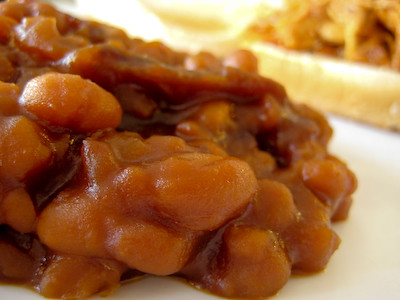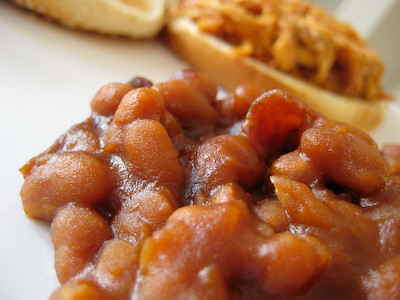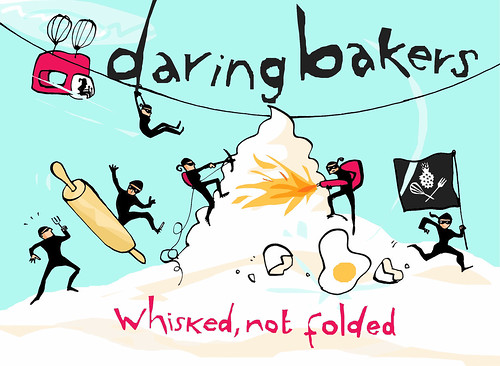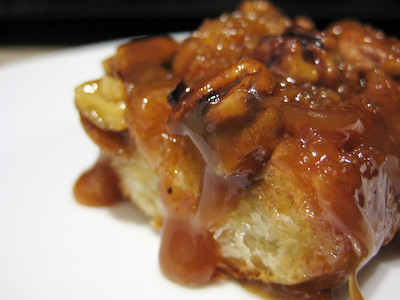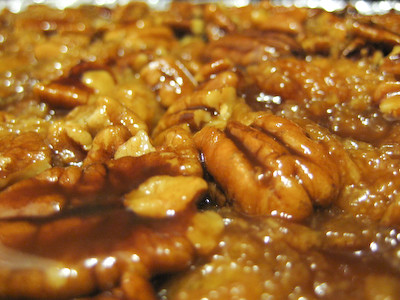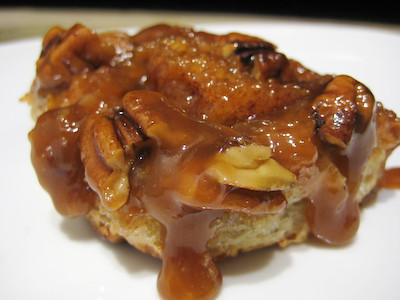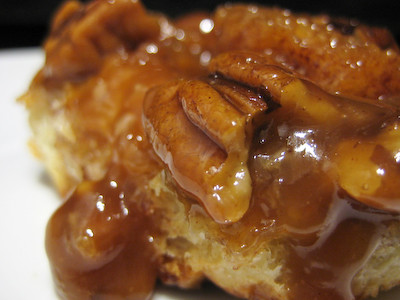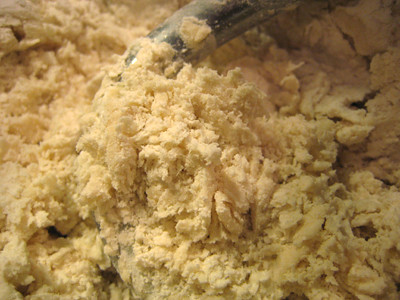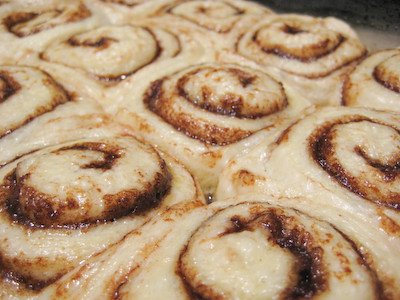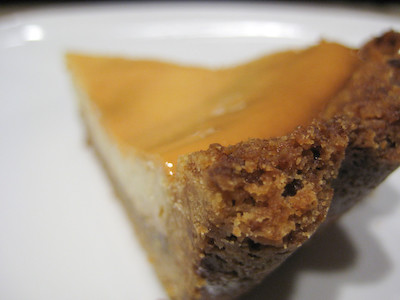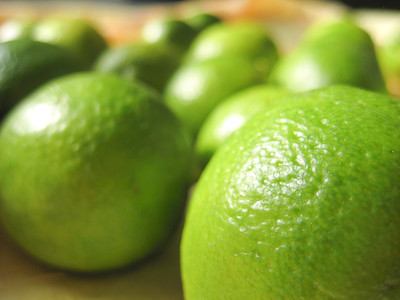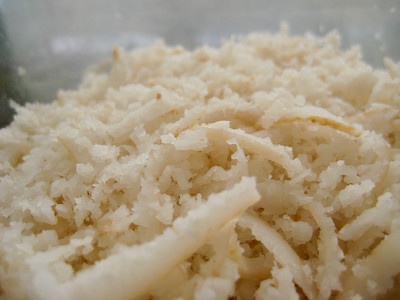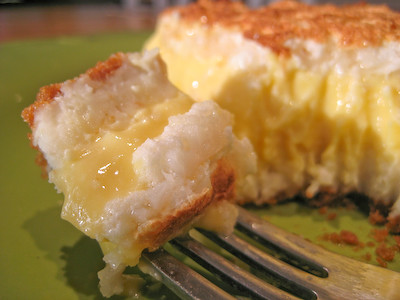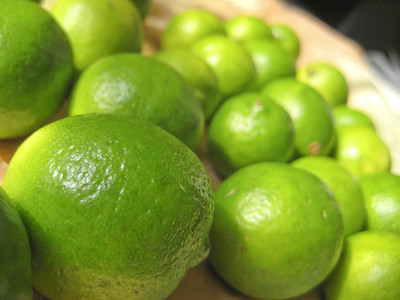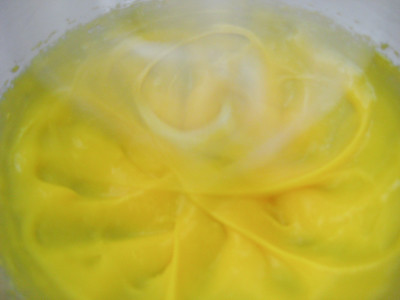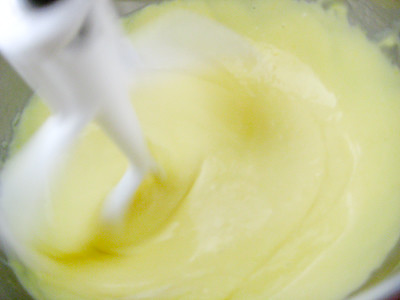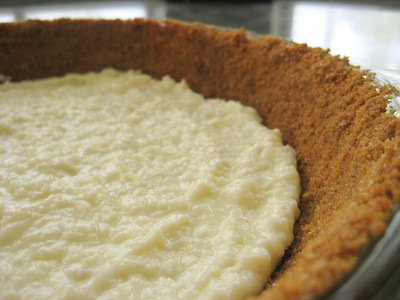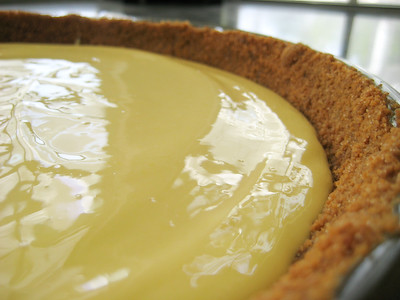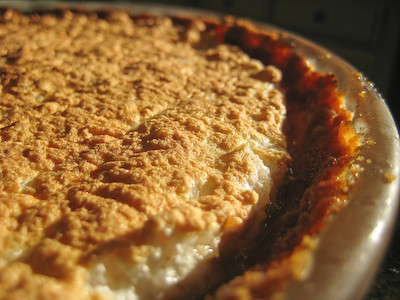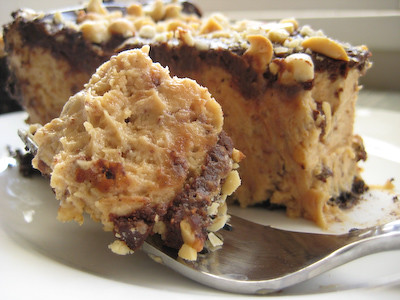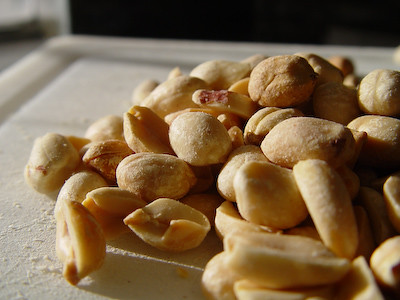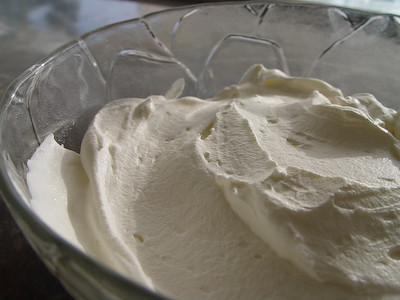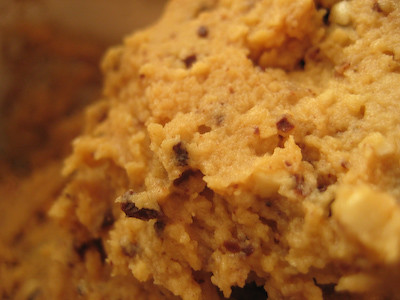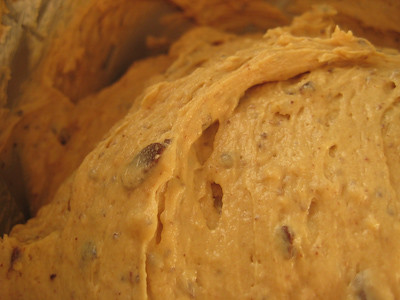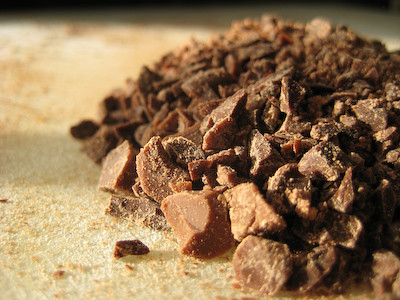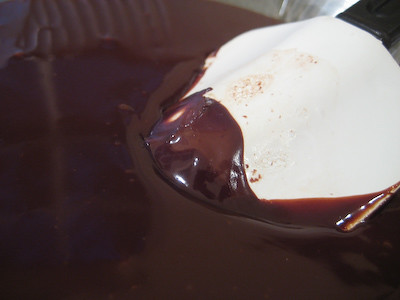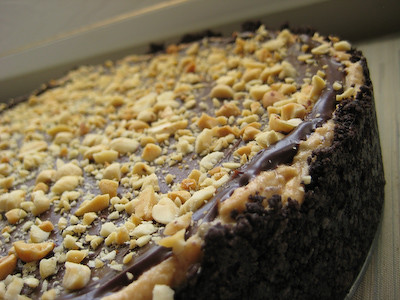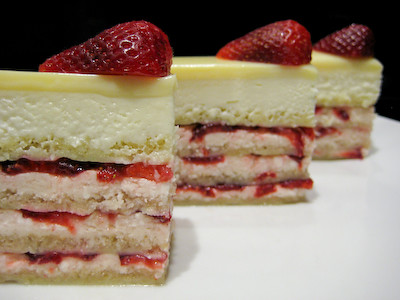
This month's
Daring Bakers Challenge was chosen by Lis of
La Mia Cucina, Ivonne of
Cream Puffs in Venice, Fran of
Apples Peaches Pumpkin Pie, and Shea of
Whiskful: the Opéra Cake. Frankly, I had never heard of the Opéra Cake before. It is a French dessert that is believed to have been created in the early 1900's. It is sometimes referred to as Clichy Cake because it is believed to have been invented by a man named Louis Clichy.
The Opéra Cake is made up of five components: a joconde (a cake layer), a syrup (to wet the joconde), a buttercream (to fill some of the layers), a ganache or mousse (to top the final cake layer) and a glaze (to cover the final layer of cake or of ganache/mousse).

Due to many different factors, I was unable to participate in
Barbara's LiveSTRONG event earlier this month. So I was glad to see that in honor of
Barbara, the Daring Bakers were making Opéra Cakes that were light in both color and flavor (traditionally, the cake is flavored with darker flavors such as chocolate or coffee). This month's challenge is dedicated to Barbara and the loved ones who are no longer with us, those who are still fighting, and those who have won the fight against cancer.
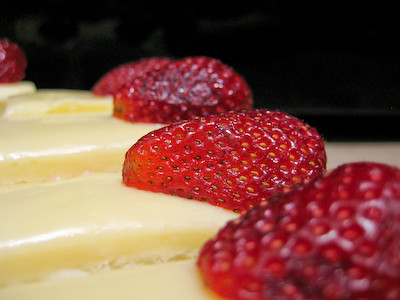
There were several rules set up for this challenge. We were not allowed to use chocolate, coffee, or cocoa in this cake. Instead, we were encouraged to use light flavors such as vanilla, coconut, lemon, almond, etc. We were also allowed to use another buttercream recipe of our choice, as long as we remained true to the "light" color and flavor theme. I had heard so many great things about
Dorie's buttercream after last month's challenge, but had not made it in the
Perfect Party Cake because I do
not like buttercream. So I thought this was the perfect opportunity to finally try it. I have only made my own buttercream once or twice before, but let me just say that Dorie's buttercream was absolutely delicious. I hate to admit it, but I even licked the spatula after I was done!
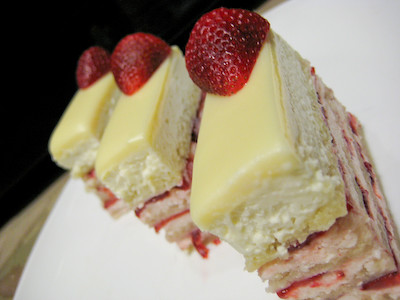
My Opéra Cake was an orange/almond joconde flavored with an orange liqueur syrup, layered with strawberry buttercream and sliced strawberries, topped with an orange infused white chocolate ganache/mousse and a white chocolate glaze.
I am not sure if it was because I made my own almond meal, but I did not really like the texture of the joconde. I made the almond meal as fine as I could, but the joconde still had a slightly coarse texture to it. My favorite part of this cake was the fresh strawberries in it. I don't think that I would have really enjoyed it without the strawberries (it would have been just too much cake and cream for me). Several bakers noted that the cake was too sweet with the ganache/mousse and omitted it, but I wanted to stay as true to the original recipe as possible so I decided to make it. It
was pretty sweet, but several people told me that it was the best part of the cake.

Everyone who tried the cake was beaming about how good it was (some even said it was the best cake they had ever had), but I was not as impressed by it. I just didn't enjoy the texture of the joconde. I am glad that I stepped up to the challenge, though, because quite frankly, I was pretty intimidated by it at the beginning. It seemed so complex and the pictures looked so much more impressive than anything I could ever make. In the end, it really isn't that difficult as long as you take it one step at a time (several components can be made ahead of time so you can make it over the course of several days). I am eager to try this recipe again to see if I will like it better with the more popular flavors of coffee, hazelnut, and chocolate. So thank you Lis, Ivonne, Fran, and Shea for choosing this recipe. You challenged me to make a cake that I would have never made on my own, and helped me discover that not all buttercreams are created equal :)
I am so impressed by all of the beautiful Opéra Cakes that I have already seen, so make sure you visit the
Daring Bakers Blogroll and see how all the other talented bakers stacked up!
Opéra CakeBased on Opéra Cake recipes in Dorie Greenspan’s Paris Sweets and Tish Boyle and Timothy Moriarty’s Chocolate Passion.
For the joconde(Note: The joconde can be made up to 1 day in advance and kept wrapped at room temperate)
What you’ll need:
2 12½ x 15½-inch (31 x 39-cm) jelly-roll pans (Note: If you do not have jelly-roll pans this size, do not fear! You can use different-sized jelly-roll pans like 10 x 15-inches.)
(I used two 13x8" half sheet pans)a few tablespoons of melted butter (in addition to what’s called for in the ingredients’ list) and a brush (to grease the pans)
parchment paper
a whisk and a paddle attachment for a stand mixer or for a handheld mixer
two mixing bowls (you can make do with one but it’s preferable to have two)
Ingredients:
6 large egg whites, at room temperature
2 tbsp. (30 grams) granulated sugar
2 cups (225 grams) almond meal (available in bulk food stores or health food stores)
2 cups icing sugar, sifted
6 large eggs
½ cup (70 grams) all-purpose flour
3 tbsp. (1½ ounces; 45 grams) unsalted butter, melted and cooled
I used approximately 1-2/3 cups of whole almonds to get the 2 cups of ground almonds for this recipe.

If you've never blanched almonds before, it's really easy. Simply place them in boiling water for about 45-60 seconds (you'll know they're done when they start floating to the top!). Remove them from the boiling water and briefly rinse with cold water. The skins will then easily pop off between your fingers (Just be careful because they are pretty slippery - our dog happily stood next to me, catching almonds as they went flying out from between my fingertips!).
To make the almond meal, just pulse the blanched almonds in your food processor with a tablespoon or two of the flour that you would use in the cake (to prevent the almonds from turning oily or pasty in the processor).
1. Divide the oven into thirds by positioning a rack in the upper third of the oven and the lower third of the oven.
2. Preheat the oven to 425◦F. (220◦C).
3. Line two 12½ x 15½- inch (31 x 39-cm) jelly-roll pans with parchment paper and brush with melted butter.
4. In the bowl of a stand mixer fitted with the whisk attachment (or using a handheld mixer), beat the egg whites until they form soft peaks. Add the granulated sugar and beat until the peaks are stiff and glossy. If you do not have another mixer bowl, gently scrape the meringue into another bowl and set aside.
5. If you only have one bowl, wash it after removing the egg whites or if you have a second bowl, use that one. Attach the paddle attachment to the stand mixer (or using a handheld mixer again) and beat the almonds, icing sugar and eggs on medium speed until light and voluminous, about 3 minutes.
6. Add the flour and beat on low speed until the flour is just combined (be very careful not to overmix here!!!).
7. Using a rubber spatula, gently fold the meringue into the almond mixture and then fold in the melted butter. Divide the batter between the pans and spread it evenly to cover the entire surface of each pan.
8. Bake the cake layers until they are lightly browned and just springy to the touch. This could take anywhere from 5 to 9 minutes depending on your oven. Place one jelly-roll pan in the middle of the oven and the second jelly-roll pan in the bottom third of the oven.
9. Put the pans on a heatproof counter and run a sharp knife along the edges of the cake to loosen it from the pan. Cover each with a sheet of parchment or wax paper, turn the pans over, and unmold.
10. Carefully peel away the parchment, then turn the parchment over and use it to cover the cakes. Let the cakes cool to room temperature.
For the syrup(Note: The syrup can be made up to 1 week in advance and kept covered in the refrigerator.)
What you’ll need:
a small saucepan
Ingredients:
½ cup (125 grams) water
⅓ cup (65 grams) granulated sugar
1 to 2 tbsp. of the flavouring of your choice (i.e., vanilla extract, almond extract, cognac, limoncello, coconut cream, honey etc.)
(I used 2 tbsp Triple Sec)1. Stir all the syrup ingredients together in the saucepan and bring to a boil.
2. Remove from the heat and let cool to room temperature.
For the buttercream(Note: The buttercream can be made up to 1 month in advance and packed in an airtight container. If made way in advance, you can freeze the buttercream. Alternatively you can refrigerate it for up to 4 days after making it. To use the buttercream simply bring it to room temperature and then beat it briefly to restore its consistency.)
What you’ll need:
a small saucepan
a candy or instant-read thermometer
a stand mixer or handheld mixer
a bowl and a whisk attachment
rubber spatula
Ingredients:
1 cup (100 grams) granulated sugar
¼ cup (60 grams) water
seeds of one vanilla bean (split a vanilla bean down the middle and scrape out the seeds) or 1 tbsp. pure vanilla extract
(I omitted this)1 large egg
1 large egg yolk
1¾ sticks (7 ounces; 200 grams) unsalted butter, at room temperature
flavouring of your choice (a tablespoon of an extract, a few tablespoons of melted white chocolate, citrus zest, etc.)
(I used 1 tbsp Triple Sec)1. Combine the sugar, water and vanilla bean seeds or extract in a small saucepan and warm over medium heat just until the sugar dissolves.
2. Continue to cook, without stirring, until the syrup reaches 225◦F (107◦C) [*Note: Original recipe indicates a temperature of 255◦F (124◦C), however, when testing the recipe I found that this was too high so we heated to 225◦F and it worked fine] on a candy or instant-read thermometer. Once it reaches that temperature, remove the syrup from the heat.
3. While the syrup is heating, begin whisking the egg and egg yolk at high speed in the bowl of your mixer using the whisk attachment. Whisk them until they are pale and foamy.
4. When the sugar syrup reaches the correct temperature and you remove it from the heat, reduce the mixer speed to low speed and begin slowly (very slowly) pouring the syrup down the side of the bowl being very careful not to splatter the syrup into the path of the whisk attachment. Some of the syrup will spin onto the sides of the bowl but don’t worry about this and don’t try to stir it into the mixture as it will harden!
5. Raise the speed to medium-high and continue beating until the eggs are thick and satiny and the mixture is cool to the touch (about 5 minutes or so).
6. While the egg mixture is beating, place the softened butter in a bowl and mash it with a spatula until you have a soft creamy mass.
7. With the mixer on medium speed, begin adding in two-tablespoon chunks. When all the butter has been incorporated, raise the mixer speed to high and beat until the buttercream is thick and shiny.
8. At this point add in your flavouring and beat for an additional minute or so.
9. Refrigerate the buttercream, stirring it often, until it’s set enough (firm enough) to spread when topped with a layer of cake (about 20 minutes).
To Make the (Strawberry) Buttercream(I used Dorie's Buttercream recipe from the Perfect Party Cake)
1 cup sugar4 large egg whites3 sticks (12 ounces) unsalted butter, at room temperature¼ cup fresh lemon juice (from 2 large lemons) (I used 1/2 cup of strawberry puree made with 4 ounces of strawberries and 1 tbsp sugar)1 teaspoon pure vanilla extractPut the sugar and egg whites in a mixer bowl or another large heatproof bowl, fit the bowl over a plan of simmering water and whisk constantly, keeping the mixture over the heat, until it feels hot to the touch, about 3 minutes. The sugar should be dissolved, and the mixture will look like shiny marshmallow cream. Remove the bowl from the heat.Working with the whisk attachment or with a hand mixer, beat the meringue on medium speed until it is cool, about 5 minutes. Switch to the paddle attachment if you have one, and add the butter a stick at a time, beating until smooth. Once all the butter is in, beat in the buttercream on medium-high speed until it is thick and very smooth, 6-10 minutes. During this time the buttercream may curdle or separate – just keep beating and it will come together again. On medium speed, gradually beat in the lemon juice, waiting until each addition is absorbed before adding more, and then the vanilla. You should have a shiny smooth, velvety, pristine white buttercream. Press a piece of plastic against the surface of the buttercream and set aside briefly.For the white chocolate ganache/mousse (this step is optional – please see Elements of an Opéra Cake below)
(Note: The mousse can be made ahead and refrigerated until you’re ready to use it.)
What you’ll need:
a small saucepan
a mixer or handheld mixer
Ingredients:
7 ounces white chocolate
1 cup plus 3 tbsp. heavy cream (35% cream)
1 tbsp. liquer of your choice (Bailey’s, Amaretto, etc.)
(I used Triple Sec)1. Melt the white chocolate and the 3 tbsp. of heavy cream in a small saucepan.
2. Stir to ensure that it’s smooth and that the chocolate is melted. Add the tablespoon of liqueur to the chocolate and stir. Set aside to cool completely.
3. In the bowl of a stand mixer, whip the remaining 1 cup of heavy cream until soft peaks form.
4. Gently fold the whipped cream into the cooled chocolate to form a mousse.
5. If it’s too thin, refrigerate it for a bit until it’s spreadable.
6. If you’re not going to use it right away, refrigerate until you’re ready to use.
For the glaze(Note: It’s best to make the glaze right when you’re ready to finish the cake.)
What you’ll need:
a small saucepan or double boiler
Ingredients:
14 ounces white chocolate, coarsely chopped
(I used 9 ounces)½ cup heavy cream (35% cream)
1. Melt the white chocolate with the heavy cream. Whisk the mixture gently until smooth.
2. Let cool for 10 minutes and then pour over the chilled cake. Using a long metal cake spatula, smooth out into an even layer.
3. Place the cake into the refrigerator for 30 minutes to set.
Assembling the Opéra Cake(Note: The finished cake should be served slightly chilled. It can be kept in the refrigerator for up to 1 day).
Line a baking sheet with parchment or wax paper.
Working with one sheet of cake at a time, cut and trim each sheet so that you have two pieces (from each cake so you’ll have four pieces in total): one 10-inch (25-cm) square and one 10 x 5-inch (25 x 12½-cm) rectangle.
(I simply cut each sheet in half to create 4 equal rectangles)Place one square of cake on the baking sheet and moisten it gently with the flavoured syrup.
Spread about three-quarters of the buttercream over this layer.
Top with the two rectangular pieces of cake, placing them side by side to form a square. Moisten these pieces with the flavoured syrup.
Spread the remaining buttercream on the cake and then top with the third square of joconde. Use the remaining syrup to wet the joconde and then refrigerate until very firm (at least half an hour).
Prepare the ganache/mousse (if you haven’t already) and then spread it on the top of the last layer of the joconde. Refrigerate for at least two to three hours to give the ganache/mousse the opportunity to firm up.
Make the glaze and after it has cooled, pour/spread it over the top of the chilled cake. Refrigerate the cake again to set the glaze.
(I made a 4 layer cake using one-third of the buttercream on each layer of cake and then topped each buttercream layer with sliced strawberries (I used about 1 lb strawberries). The fourth layer of cake was then topped with the ganache/mousse and glaze.)
Serve the cake slightly chilled. This recipe will yield approximately 20 servings.
